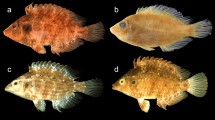Abstract
Twelve new and known species of the genera Sabatieria,Cervonema, Paramesonchium, Hopperia and Dorylaimopsis and one new genus, Kenyanema aredescribed from the Indian Ocean and S. pisinna Vitiello,1970 from the Mediterranean Sea. Sabatieria lucia sp. n.is characterised by short but distinct inner and setiformouter labial sensilla and long (4–5 µm or 30–33% hd)cephalic sensilla; S. conicauda Vitiello, 1970, ischaracterised by tiny inner and outer labial sensilla andsetiform cephalic ones and short and thick cylindrical tail;Sabatieria pisinna is characterised by short innerand outer labial sensilla, setiform (3µm long) cephalicsensilla, multispiral amphids with 3.25–3.5 turns and a tailwhich is conical in the anterior 2/3 and posterior 1/3cylindrical; Cervonema tenuicauda Schuurmans Stekhoven,1950, is characterised by anterior sensilla in twocircles which are equal in length (3µm long), multispiralamphids with 3–4 turns and located at 1.5 times hd from theanterior end, simple spicules one abd long and 6–7 fineprecloacal supplements; Cervonema minutus sp. n.characterised by an extremely attenuated anterior end,spiral amphids with 4–5 turns (80–90% cbd) and short,simple spicules (0.8 abd long); Cervonema gourbaulti sp.n. characterised by long (4–5 µm) labialand cephalic sensilla, spiral amphids with 5–6 turns(73–88% cbd) and an elongate crenate terminal pharyngealbulb; Paramesonchium mombasi sp. n. characterised bylong labial (5 µm) and cephalic (21 µm) sensilla thatare close together and wide amphids (80–90% cbd); Kenyanema monorchis gen. et sp. n. characterised bya head region narrower than the rest of the body, fourcephalic sensilla (3 µm long) and spiral amphids with1.5–2 turns; Hopperia indiana sp. n. characterised byshort conical anterior sensilla, arcuatespicules that have a ‘velum’ and a gubernaculum with a longand sharp pointed apophysis; Dorylaimopsis coomansi sp.n. characterised by long (8–10µm) cephalic setae,cuticular punctation with lateral differention of irregularlyarranged dots at the pharyngeal region and 1–3longitudinal rows of dots posterior of the pharynx; spiculeswith a unique shape; Dorylaimopsis gerardi sp. n.characterised by short setiform labial and long (6–7 µm)cephalic sensilla, punctated cuticle with lateraldifferentiation of irregularly arranged dots at firstthen three or four irregularly arranged longitudinal rows atthe pharyngeal and tail regions and two regularly arrangedlongitudinal rows of dots on the rest of the body, aconico-cylindrical tail with a distinctly swollen tip;Dorylaimopsis variabilis sp. n. is characterised byshort labial and setiform cephalic sensilla (33–58% hd),multispiral amphids with three turns, cuticular punctationswith lateral differentiation of three longitudinalrows at the pharyngeal and tail regions and two longitudinalrows on the rest of the body, spicules that are thin andslightly arcuate. The position of S. pisinna accordingto the grouping of Platt, 1985 of Sabatieriaspp. is also discussed. Kenyanema monorchis representsthe first monorchic species in the family.
Similar content being viewed by others
References
Jensen, P., 1976. Free-living marine nematodes from the sub-littoral station in the North Sea off the Belgian Coast. Biol. Jaarb. Dodonaea 44: 231–255.
Jensen, P., 1978. A review of the Comesomatidae (Free-living marine nematodes). Ann. Soc. r. zool. Belg. 108: 25–27.
Jensen, P., 1979. Revision of Comesomatidae (Nematoda) Zool. Scr. 8: 81–105.
Jensen, P., 1988. Nematode assemblages in the deep-sea benthos of the Norwegian Sea Deep Sea Res. 35: 1173–1184.
Jensen, P., 1988a. Four new nematode species abundant in the Deep-Sea Benthos of the Norwegian Sea. Sarsia 73: 149–155.
Platt, H. M., 1982. Revision of the Ethmolaimidae (Nematoda: Chromadorida). Bul. B. mus. (Nat. Hist.) Zool. 43: 185–252.
Platt, H. M., 1985. The free-living marine nematode genus Sabatieria(Nematoda:Comesomatidae). Taxonomic revision and pictorial keys. Zool. J. Lin. Soc. 83: 27–78.
Riemann, R., 1986. Nicascolaimus punctatusgen. et sp. n. (Nematoda, Axonolaimoidea), with notes on sperm dimorphism in free-living marine nematodes. Zool. Scr. 15: 119–124.
Schuurmans, S., 1950. The free-living maring nematodes of the Mediterranean. II The Bay of Villefranche. Mém. Inst. r. nat. Belg. 2 sér. 37: 1–220.
Soetaert, K. & C. Heip, 1995. Nematode assemblages of the deep sea and Shelf break sites in the North Atlantic and Mediterranean sea. Mar. Ecol. Prog. Ser. 125: 171–183.
Vitiello, P., 1970. Nématodes libres marins des vases profondes du golfe du Lion. II Chromadorida. Tethys 2: 449–500.
Wieser, W., 1954. Free-living marine nematodes. II Chromadoroidea Reports. Acta Univ. Lund N.F. Avd. 2, 50(6) 148 pp.
Author information
Authors and Affiliations
Rights and permissions
About this article
Cite this article
Muthumbi, A.W., Soetaert, K. & Vincx, M. Deep-sea nematodes from the Indian Ocean: new and known species of the family Comesomatidae. Hydrobiologia 346, 25–57 (1997). https://doi.org/10.1023/A:1002989210231
Issue Date:
DOI: https://doi.org/10.1023/A:1002989210231




